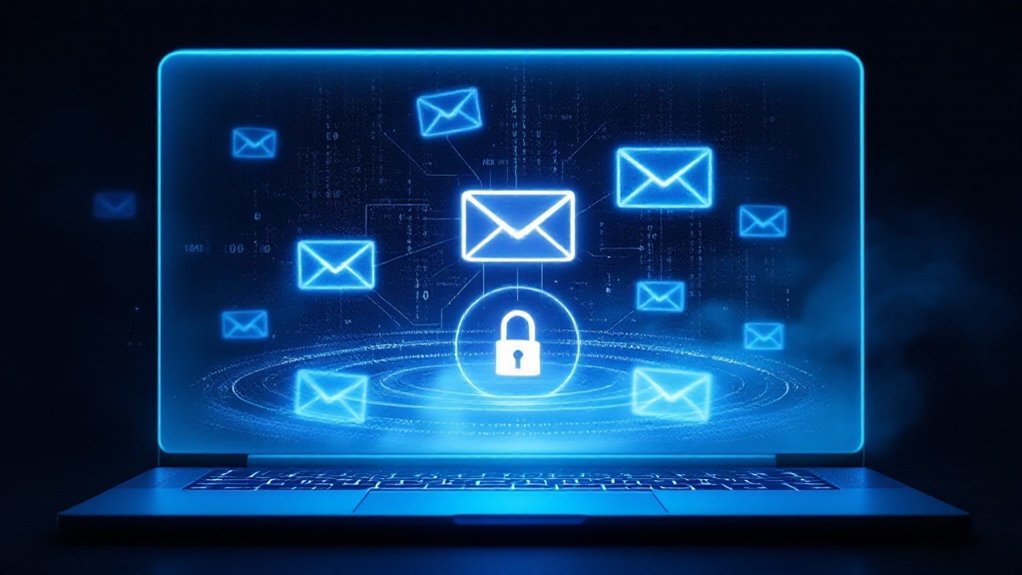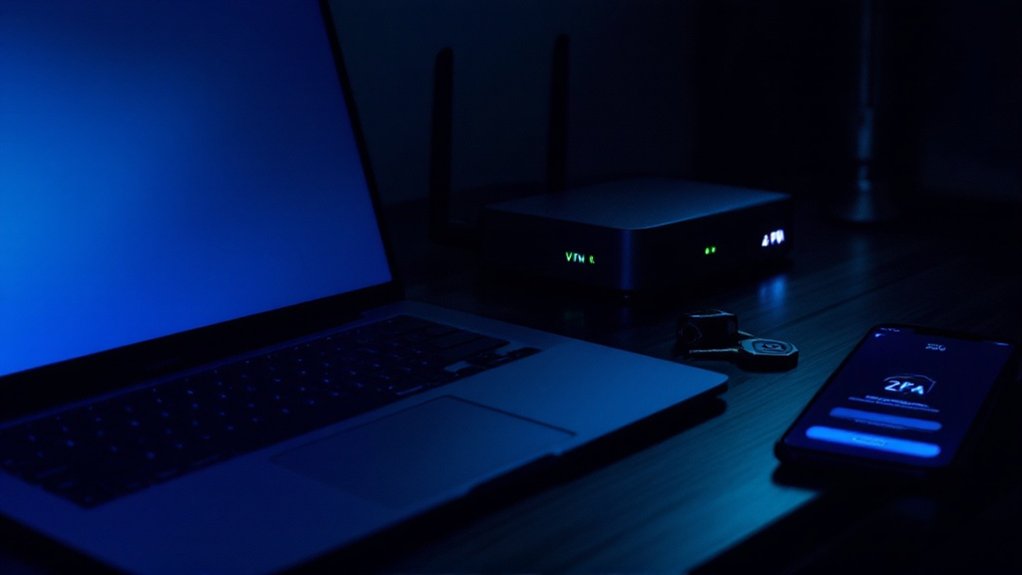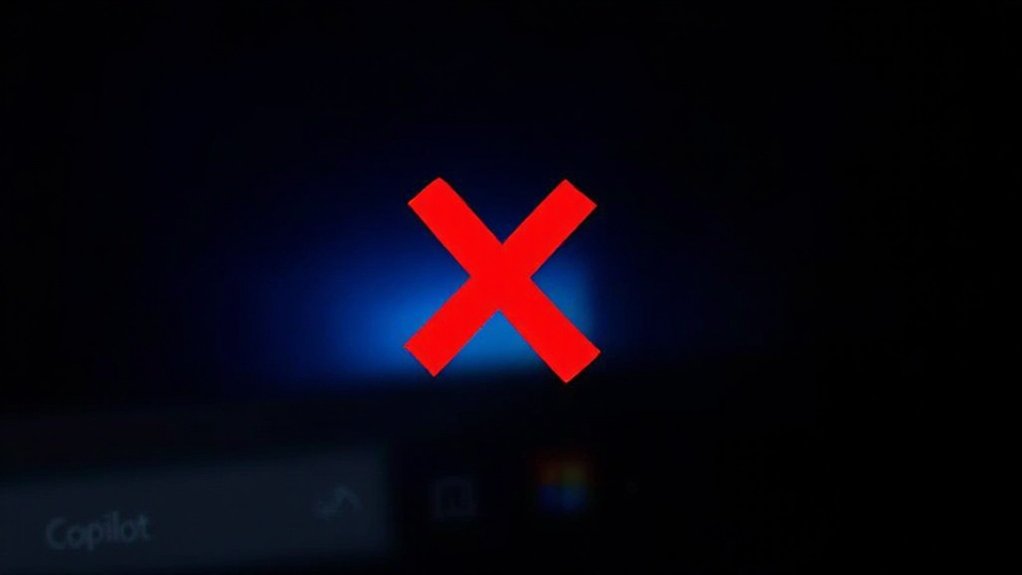To send anonymous emails securely, users must implement multiple layers of protection through encrypted email services like ProtonMail or Tutanota, during masking their IP address with a VPN or Tor network. Crucial steps include stripping metadata from attachments, using disposable phone numbers for verification, and creating separate accounts for different purposes. Combining end-to-end encryption with two-factor authentication and careful digital footprint management establishes a thorough framework for private communication. Further technical measures can improve this security protocol.

Even though digital communication has become an integral part of modern life, maintaining privacy and anonymity in email correspondence remains a growing concern for individuals seeking to protect their personal information. Security experts recommend utilizing anonymous email providers that offer strong encryption features, with services like ProtonMail and Tutanota emerging as leading choices because of their end-to-end encryption capabilities and advanced security measures such as two-factor authentication.
Creating an anonymous email account requires careful attention to detail and multiple layers of protection. End-to-end encryption ensures confidential messages remain private between sender and recipient. Users should begin by selecting a provider that aligns with their privacy needs, then register using a pseudonym and fabricated personal information. When verification is required, disposable phone numbers can be utilized to maintain anonymity.
To prevent identity correlation, separate email accounts should be established for different purposes. The foundation of anonymous email communication lies in masking one’s digital footprint through IP address concealment. This can be achieved by implementing a Virtual Private Network (VPN) or accessing email services through the Tor network. Some providers, like NordVPN, offer specialized features such as Onion over VPN for improved privacy protection. Gmail and Outlook are not recommended for maximum anonymity due to their limited privacy measures. ProtonMail’s Swiss data centers provide additional security due to the country’s strict privacy laws.
Public Wi-Fi networks can provide an additional layer of location obscurity when combined with these tools. File attachments pose a particular risk to anonymity because of embedded metadata. Users must carefully strip location data from images and remove identifying information from documents before transmission.
Converting files to plain text format and utilizing open-source editing tools can help eliminate hidden personal information that might compromise anonymity. For situations requiring temporary email access, services like Temp-Mail and Mailinator provide disposable addresses that expire after predetermined periods.
These “burner” email services prove particularly useful for website registrations and one-time communications. To maximize security, users should combine multiple anonymity methods, implementing VPN protection, metadata removal, and encrypted messaging features simultaneously. When properly executed, these techniques create a strong framework for maintaining email privacy in an increasingly connected digital environment.
Frequently Asked Questions
Can Law Enforcement Track Anonymous Emails Back to the Original Sender?
Law enforcement agencies can trace anonymous emails through court-ordered IP address tracking, email header analysis, and digital forensics techniques.
Nevertheless, success rates vary markedly when encryption, VPNs, or anonymous email services are used.
Although agencies possess sophisticated tools and can collaborate with ISPs and international partners, tracking becomes exponentially more difficult with each layer of anonymity employed by the sender.
Is It Legal to Send Anonymous Emails in All Countries?
The legality of anonymous emails varies markedly between countries. Although anonymous emailing itself is typically permitted in most nations, several jurisdictions impose strict regulations.
Germany, Australia, Canada, France, and the Netherlands require sender identification, particularly for commercial messages. Violations of these requirements can result in substantial penalties.
The determining factor often lies not in anonymity itself, but rather in the email’s content and intended purpose.
What Happens if the Recipient Tries to Trace My Anonymous Email?
Recipients attempting to trace anonymous emails have several technical options, including analyzing IP addresses, email headers, and metadata.
Nevertheless, properly implemented countermeasures like VPNs, Tor networks, and secure email services can effectively prevent tracing.
Meanwhile, law enforcement may obtain records through legal channels with valid warrants. Individual recipients face significant barriers when trying to unmask anonymous senders who utilize appropriate privacy tools and best practices.
Do Anonymous Email Services Keep Logs of User Activity and IP Addresses?
Anonymous email services vary considerably in their logging practices.
Although many advertise “no-logs” policies, most retain some data temporarily for technical operations and troubleshooting. Common logs include IP addresses, login timestamps, and basic metadata, typically stored for 24-72 hours.
Premium services typically maintain stricter privacy standards, whereas free providers often preserve more extensive records.
Local data retention laws and law enforcement requirements likewise influence individual provider policies.
Can Employers Detect if Work-Related Emails Are Sent Through Anonymous Services?
Employers can detect anonymous email usage through various technical means, including monitoring network traffic, IP address tracking, and email metadata analysis.
Company IT departments commonly maintain logs of all outbound communications, whereas email servers record identifying information that can reveal the use of anonymous services.
Furthermore, suspicious email patterns, unusual routing signatures, and certain header characteristics often indicate attempts to mask sender identity through anonymizing platforms.









